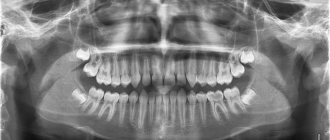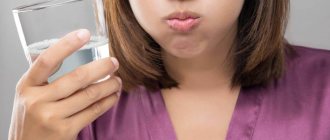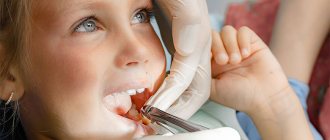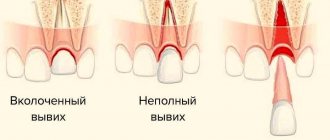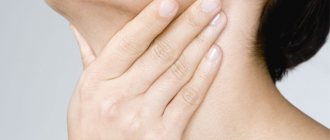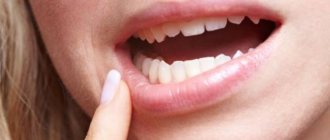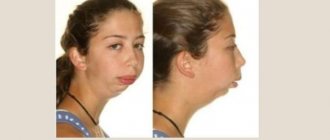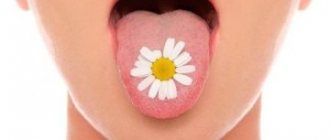Hypersalivation (salivation, ptyalism) is an increased production of secretion by the salivary glands, that is, saliva. As a physiological phenomenon, ptyalism is observed in children in the first half of life. At any other age, increased secretion of saliva indicates one or another pathology.
The salivary glands of an adult secrete about 2 liters of saliva per day. Normally, it does not leak from the oral cavity; there should also be no need for frequent swallowing or spitting.
In children in the first half of life, hypersalivation is a physiological phenomenon.
Hypersalivation in infants
A small person salivates profusely - a natural process. Or rather, involuntary. After all, a child still experiences discomfort from excessive dampness, and in order to get rid of it, he unconsciously gradually learns to somehow control his reactions.
He wanted to eat, began to cry and began to call his mother, saliva was released. But over time, it begins to stand out only from the moment he is put to the breast, not earlier.
It is bad when such hypertrophied salivation is observed at an older age, or even remains immediately after six months of the baby’s development.
Then ptyalism may be evidence:
- Amyotrophic lateral sclerosis.
- Neuroleptic syndrome.
- Epidemic encephalitis.
- Parkinson's disease.
Or be a companion to such a congenital disease as cerebral palsy.
A milder case is thrush, which can be easily suppressed with antibacterial or antifungal drugs that are harmless to children.
True, in the period from 6 months to 2 years, hypersalivation occurs as a companion to teething in a child, when the salivary glands cannot cope with the already developed reflexes. They themselves have just begun to function normally, and then a powerful irritating factor appears in the form of unusual objects next to them.
A particularly strong reaction is observed in three pairs of the most efficient glands: submandibular, sublingual parotid. But small salivary glands located on the tongue, on the epithelium of the inner side of the cheeks, and the palate of the lips also contribute to abundant salivation. Moreover, in the characteristics of saliva, all the variety of secretions is noted, from serous to mucous, mixed and in pure form.
And all this “wealth” makes a person literally choke on saliva. And at a young age, when control habits have not been developed or this cannot be done due to physiological characteristics, saliva is not retained in the mouth, flowing out.
At a conscious age, if everything is in order with the intellect of a child (and even more so of an adult), such a pathology, with the awareness of it as an aesthetic defect, becomes a source of worry and anxiety, and certainly requires treatment.
Excessive drooling during sleep
Normally, the activity of the glands that produce saliva decreases during night sleep. If, after waking up, it is discovered that the pillow is wet, then spontaneous activation of the salivary glands has occurred. This is why an adult drools during sleep.
This happens when salivation increases, the body, relaxed during sleep, does not have time to react, swallowing liquid does not occur, and as a result, saliva flows profusely. The occurrence of such isolated cases is not a violation and a sign of an existing pathology. But manifestations that occur constantly require the intervention of a specialist: excessive salivation during sleep can accompany a serious illness.
Among the main factors that provoke nighttime hypersalivation are:
- Missing teeth, creating holes in the dentition through which saliva can leak from the mouth at night. An incorrect bite makes it impossible for the dentofacial rows to come into close contact, which is what causes the phenomenon.
- Diseases that provoke disturbance or complete absence of nasal breathing: a common cold, a runny nose in which the mucous membrane swells or snot flows, otolaryngological diseases, a deviated nasal septum - all these are the reasons for drooling during sleep. Impaired nasal breathing forces the sleeper to actively breathe through the mouth without closing the lips, so the accumulated moisture flows out. In such cases, the flow of saliva is accompanied by snoring. Most often, when the disease is eliminated, the accompanying symptoms, including ptyalism, disappear.
The reason why adults drool may be due to sound sleep. In this case, the person is not able to control his reflexes, the liquid is not swallowed in a timely manner, it collects in the mouth - the excess flows out.
Causes of the disease
- The body's protective reaction to the presence of a foreign body in the mouth. Or the presence of objects that the body perceives as foreign at first (growing teeth, installation of dentures or implantation of implants in the gums, which can cause hypersalivation in adults). This condition is temporary and does not require treatment. It is considered as an unconditional reflex increase in the production of salivary gland secretions and a protective reaction of the body.
- Hypersalivation of a different etiology, including congenital nature. Or acquired as a result of injuries, infections or factors that caused developmental failure. Then, in the treatment of pathology, the emphasis is on eliminating the disease-cause that caused ptyalism. Or mitigating the consequences of the disease that caused it.
- Diseases of the nervous system of various etiologies, including those caused by traumatic or infectious damage to the brain.
- Diseases of the oral cavity that have a dental coloring: gingivitis, stomatitis, sialadenitis, or inflammation of the salivary glands.
- For diseases associated with the gastrointestinal tract: pancreatitis, gastritis, ulcers (stomach and duodenum).
- Cerebral infections in the form of rabies or tick-borne encephalitis (the first is deadly without timely administered serum).
- Neurological disorders in the form of brain tumors, strokes, bulbar palsy, cerebral palsy, developmental delays, schizophrenia, psychosis, hysteria with motor hyperactivity, trigeminal neuritis.
- Poisoning by metals or halides.
- Worms in such quantities that their waste products cause poisoning of the body.
- Lack of nicotinic acid in the diet.
- The use of M-cholinomimetics, lithium salts, anticonvulsants, even in cases where they are indicated in the treatment of concomitant diseases, but the consequences of hypersalivation have not been calculated.
Prerequisites for the disease
The main causes of increased salivation in adults include:
- Inflammatory processes in the oral cavity and pharynx: gingivitis, tonsillitis, periodontitis, stomatitis, ARVI. In this case, increased salivation is a protective reaction of the body, allowing the oral cavity to be freed from pathogenic microbes, infectious agents, and tissue decay products.
- Gastrointestinal disorders: ulcers, gastritis, neoplasms, pancreatitis, cholecystitis. Microorganisms entering the oral cavity from the gastrointestinal tract have an irritating effect on the glands and gums. This provokes the development of ptyalism.
- Neuralgic disorders: brain injuries, cerebral palsy, inflammation of the trigeminal nerve, Parkinson's disease. These pathologies are accompanied by disturbances in swallowing and respiratory function, increased secretion of the salivary glands with nausea and vomiting.
- Paralysis of the muscles of the maxillofacial region. If the facial nerve is damaged, a person is unable to control facial muscles, which leads to drooling.
- Mumps is an inflammatory process in the salivary glands. The disease causes not only excessive salivation, but also swelling of the face and neck (mumps).
- Mechanical irritations. This includes dental procedures, manipulations that damage the gums: removal of stone, tooth, implantation. Ptyalism in this case is temporary.
- Medicinal ptyalism. It is a side effect when taking medications that irritate the salivary glands, which causes their activation. In this case, excessive salivation is temporary and disappears after stopping the medication.
- The onset of menopause may also be accompanied by increased glandular activity, accompanied by frequent flushing and excessive sweating. Over time, the process of saliva production returns to normal.
- Increased saliva production can cause pregnancy. The resulting toxicoses provoke profuse salivation, accompanied by nausea and vomiting.
The cause of severe salivation can be a hormonal imbalance that occurs against the background of a disorder in the functioning of the thyroid gland.
Types of hypersalivation
Both in older children (not infants) and in adults, hypersalivation can be based on two mutually exclusive mechanisms:
- The salivary glands increase their secretion, producing more than 2 and a half liters per day. This type of salivation is called true hypersalivation.
- Another type (false hypersalivation) manifests itself in a violation of the processes of swallowing saliva, when it is produced no more than normal. This type of disease, without intensification of salivary processes, occurs 3-4 times more often than the first type.
Drug hypersalivation
Intense salivation is caused by drugs with lithium or nitrazepam, which, in turn, can provoke xerostomia with a severe wound.
Xerostomia is a critical deficiency of salivary secretion, usually occurring with an overdose or too long exposure of the body to drugs during the treatment of hypersalivation. Symptoms of xerostomia are dry mouth, burning of the lips and tongue, angular cheilitis in the corners of the mouth (“jams”), dry red border on the lips with the formation of crusts and bleeding microcracks, “folded tongue.”
Sialodohit
This inflammation of the salivary ducts, as an independent disease, also often causes hypersalivation. It happens in older people, and even more often in old age. A constant companion of sialodochitis is the appearance of painful microcracks in the corners of the mouth.
Salivation during sleep
There have been many cases where copious salivation occurs only during sleep. The causes of nighttime drooling in adults were:
- Improper daily routine with chronic fatigue syndrome, when sleep resembles loss of consciousness.
- Infestations of worms with their excessive reproduction.
- Reduced acidity of gastric juice with gastritis.
- Malocclusion.
- Missing one or more teeth in the mouth.
- ENT diseases that make breathing difficult during sleep. In this case, the oral mucosa quickly dries out, and the mechanism of focal compensation is activated, when some salivary glands begin to work several times more actively.
A special case is ptyalism in women during pregnancy, which is based on purely physiological reasons. It develops against the background of changes occurring in the gastrointestinal tract, and most often in the first trimester of pregnancy. May be accompanied by severe heartburn, nausea, and vomiting.
Psychogenic course of the process
It is extremely rare, but it is even more difficult to treat than traumatic or infectious lesions. With this type of hypersalivation, any signs of damage to the nervous system and inflammatory processes may be completely absent. But salivation in this case is even more abundant than with injuries and infectious lesions. To such an extent that those suffering from this form of hypersalivation have to carry a saliva bag with them.
The problem can only be solved by surgical methods or the use of radiology or cryotechnology.
Bulbar and pseudobulbar syndromes
The amount of saliva produced during bulbar pseudobulbar syndrome depends only on the severity of the processes occurring during the disease. Pathologies include syringobulbia, poliomyelitis, degenerative diseases, and vascular diseases.
In extreme cases of the disease, saliva output can reach 1 liter per day. This course of the disease not only dehydrates the body, but deprives it of many elements, since saliva itself is an infiltrate of blood and lymph. The need to constantly carry a saliva collector or towel with you to collect secretions does not contribute to psychological comfort and looks anti-aesthetic.
Dental pathologies
Radiotherapy can be used as a radical treatment. But sometimes the very fact of irradiation can also provoke hypersalivation. Dental pathology is also possible with ulcerative stomatitis, toxicosis of any nature and helminthic infestations.
In all these cases, both conservative treatment with therapeutic methods (only with the use of potent drugs) and surgical intervention are possible.
Kinds
Depending on the mechanism of development, hypersalivation occurs:
- True - associated with increased secretion of the salivary glands.
- False (pseudohypersalivation) is the result of a violation of the mechanism of swallowing saliva (against the background of sore throat, lesions of the facial nerve, cerebral palsy, etc.).
In severe cases of hypersalivation, patients experience damage to the skin of the face associated with the irritating effect of saliva.
In accordance with the cause that caused true hypersalivation, there are:
- bulbar and pseudobulbar hypersalivation, that is, manifested in bulbar and pseudobulbar syndromes in cerebral vascular pathology, neurodegenerative diseases, poliomyelitis, etc.;
- somatic – caused by somatic pathology. Observed during radiation therapy, toxicosis of pregnancy, ulcerative stomatitis, helminthiasis, and a number of malignant tumors;
- medicinal – a side effect of therapy with lithium or Nitrazepam;
- psychogenic - this is the rarest type, develops under the influence of psychotraumatic factors, and sometimes the cause cannot be identified.
Symptoms
All cases of increased salivation should be the basis for close medical supervision. The doctor must pay attention to how the patient behaves: whether he swallows saliva or the process of its secretion is not controlled by the patient. In the second case, this process is most often not controlled, and its consequences are redness of the skin at the corners of the mouth and a pustular rash. In their sleep, such people usually get their pillow wet with saliva. Children have constantly wet clothes, especially in the chest and collar area.
Signs
With hypersalivation, patients complain of rapid accumulation of saliva in the mouth, which forces them to make frequent swallowing movements. With severe ptyalism, saliva leaks from the corners of the mouth. This, in turn, leads to a violation of the integrity (maceration) of the skin of the chin and lower cheeks. When a secondary infection occurs in the area of damaged skin, a pustular rash appears.
With hypersalivation, saliva quickly accumulates in the oral cavity and leaks from the corners of the mouth
Diagnosis of hypersalivation
The nature of increased salivation is clarified, what preceded it, what painful sensations (if any) were accompanied. All accompanying symptoms are recorded.
The swallowing ability itself is checked, with the participation of a dentist or after his consultation, a conclusion is made about the condition of the oral cavity.
Testing the functioning of the salivary glands using typical reflexes. The amount of saliva secreted in a calm state is determined. If more than 10 ml of saliva is released in 20 minutes, this can be considered abnormal.
Based on the results of the examination, the patient can be sent to specialized specialists: dentist, gastroenterologist, neurologist.
The dentist diagnoses the presence or absence of gingivitis, caries, stomatitis, as well as the need for dentures or braces.
The neurologist will deal with possible acquired nervous disorders of an infectious or traumatic nature.
A gastroenterologist examines the secretory functions of the salivary glands in the light of their interaction with the digestive organs. It is not so rare that problems with intense salivation are associated specifically with the gastrointestinal activity of the body.
For an accurate diagnosis, clarifying procedures may be prescribed in the form of the following laboratory tests:
- Polymerase chain reaction.
- Cytological analyses.
- Biological analyses.
- Biopsies of glandular tissue.
- Immune tests.
- Analyzes related to microbiological activity in the glandular area.
Diagnostics
Diagnosing hypersalivation does not cause difficulties; it is much more difficult to find out the cause of its occurrence. To do this, carefully collect anamnesis, then examine the functional activity of the salivary glands. With true hypersalivation, the patient secretes over 10 ml of saliva in 20 minutes (the norm is from 1 to 4 ml).
The salivary glands of an adult secrete about 2 liters of saliva per day. Normally, it does not leak from the oral cavity.
Depending on the medical history and initial examination, the patient is referred for consultation to specialized specialists (gastroenterologist, dentist, neurologist, infectious disease specialist, psychiatrist).
Treatment
It is selected based on the medical history and consists of eliminating the root cause of the disease. If hypersalivation is associated with gastritis, then to eliminate dyspeptic symptoms, drugs are prescribed that increase the acidity of gastric juice.
The dentist will use antiseptic solutions. In his case, dental problems will be detected with a change in the microflora of the oral cavity towards intensive proliferation of bacteria in soft deposits on the teeth. And these soft deposits in the near future will not only cause the formation of tartar, but will also aggravate the existing hypersalivation.
Standard Actions
- Use anticholinergics - drugs that reduce the secretory activity of the salivary glands.
- For adults, it is possible to use biofeedback therapy if the importance of auto-training can be conveyed to the patient.
- As a radical remedy, surgery can be used to remove the most active and large glands.
- Cryotherapy as a type of surgical intervention. Only instead of a scalpel, extremely low temperatures inherent in liquid nitrogen are used.
- Radiotherapy with irradiation with a directed narrow beam of gamma radiation, suppressing the activity of the salivary gland selected for this.
- Injection of botulinum toxin into the parotid glands. This allows you to block their activities for 6-8 months.
Treatment of pregnant women
Radical methods with them are unacceptable, therefore palliative methods of influencing the salivary glands are used:
- Small doses of atropine to suppress salivary secretion.
- Exclusion from the diet of foods high in starch or acids - even such beneficial ones as ascorbic acid.
- Constant use of mouthwashes with menthol or sage infusions.
Any treatment method may have contraindications or cause side effects. There have been cases when, in order to get rid of the causes and symptoms of this disease, it was enough for the patient to change the diet, excluding from it substances that irritate some body systems or, conversely, introducing them into the menu.
Sometimes increased physical activity helped get rid of excessive salivation syndrome. And sometimes - an exception from the list of habits of caffeine, alcohol and smoking.
Hypersalivation during pregnancy
Frequent salivation in women is often caused by such an exciting and important stage as pregnancy. Numerous changes that occur in the female body can provoke various disorders, including ptyalism.
The main reasons that cause excessive salivation in the expectant mother:
Heartburn. When an acid imbalance occurs, a lot of saliva is produced, which is a protective reaction against increased acid levels.- Reaction to medications. The internal transformations a pregnant woman undergoes may manifest itself in an inadequate perception of medications.
- Toxicoses. Increased salivation and nausea, vomiting occur before, during and after eating. A similar condition can appear even before drinking water. With toxicosis, the syndrome often has no connection with a real increase in the work of the salivary glands. A pregnant woman tries to cope with nausea and suppress the urge to gag, so she swallows less often. As a result, there is a feeling that liquid begins to accumulate in the oral cavity.
Usually, excessive salivation does not cause complications in expectant mothers and does not threaten the fetus. But the condition needs to be monitored, since sometimes drooling can be a consequence of serious illnesses.
With uncontrolled ptyalism, the following complications may occur:
- Violation of adequate taste perception, food aversion.
- Sharp weight loss. Carrying a child requires significant energy expenditure and a large amount of nutrients and elements. Rational nutrition is necessary for a favorable pregnancy and fetal development. Reluctance to consume food causes weight loss.
- Dehydration of the body.
- Psycho-emotional disorders, insomnia.
- Deterioration of the condition and color of the skin of the face.
- Infectious lesions.
Folk remedies for treating hypersalivation
In mild cases, hypersalivation can be treated with folk remedies:
- Decoctions of water pepper and fruits with Shepherd's purse seeds. Used for intensive mouth rinsing.
- Decoctions of viburnum berries, without added sugar.
- Lemon. The slices are chewed along with the zest, the essential oils of which also have a beneficial effect on possible lesions in the mouth.
- Chamomile – both ordinary meadow chamomile and pharmaceutical chamomile. Pharmacy, due to its greater activity, is used in decoctions of lower concentrations.
Doctors do not recommend using folk remedies without consulting them, since the patient may not know the full picture without a detailed medical examination. Such treatment methods can only be effective in combination with medications, serving as a supporting and mitigating factor.
Causes of drooling
Physiological factors
The symptom is observed in most women in the first trimester of pregnancy. The appearance of drooling is associated with reflex irritation of the nerve centers that control the production of saliva. The intensity of the manifestations varies: from single nighttime episodes of sialorrhea to constant and uncontrolled flow of saliva, when a woman loses up to 3-5 liters of fluid per day. Drooling is normal in infants and children during the eruption of primary and permanent teeth.
Mechanical irritation of the oral cavity
Hypersalivation, with saliva flowing from the corners of the mouth, is a common problem for people who start wearing removable dentures. Over the course of several months, adaptation to the foreign body occurs, and the amount of saliva released gradually decreases. Short-term sialorrhea is observed during dental procedures, the use of chewing gum or sucking candy. Drooling occurs in many smokers.
Dental diseases
Sialorrhea often develops with stomatitis, gingivitis, and dental caries. The symptom is associated with irritation of M-cholinergic receptors in the mucosa. Drooling is moderate and appears more often at night. During the day, there may be a slight leakage of saliva, which accumulates in the corners of the mouth. In addition to increased salivation, patients complain of soreness and burning in the mouth, pain when chewing and swallowing, and bad breath.
Gastrointestinal diseases
Sialorrhea is possible when the stomach and initial parts of the intestines are affected. Its most typical appearance is in chronic pancreatitis, cholecystitis, and peptic ulcer. The symptom occurs at any time of the day and is often accompanied by heartburn and an unpleasant taste in the mouth. A combination of drooling with abdominal pain, nausea and vomiting, and stool disorders is typical.
ENT diseases
The flow of saliva is typical for people who have difficulty breathing through their nose and sleep with their mouth open. It occurs in patients with sinusitis, chronic rhinitis, and in children with adenoids. Drooling develops primarily during sleep. Due to the constant drying of the mucous membrane, a small amount of viscous saliva is released, accumulating on the skin of the perioral zone or leaving marks on the bed linen.
Worm infestations
The reproduction of helminths in the gastrointestinal tract causes irritation of peripheral receptors, reflexively activating the secretion of saliva. A specific sign of helminthiasis is salivation, which is disturbing at night. A person will know that there is a problem by wet spots on the pillowcase and pajamas. Dried crusts of saliva are visible in the corners of the mouth after waking up. Symptoms are supplemented by abdominal pain, dyspeptic disorders, and itching in the anal area.
Neurological pathologies
The symptom occurs in pathological processes affecting the centers of regulation of salivation. Drooling is one of the first signs of Parkinson's disease, a cerebral tumor. In such conditions, saliva is produced in large quantities and must be constantly swallowed. As problems with swallowing later arise, saliva begins to flow from the corners of the mouth.
Drooling can be caused by impaired innervation of the facial muscles and the inability to completely close the mouth. The manifestation is pathognomonic for facial nerve paralysis and residual effects of a stroke. Saliva always drains from one side of the mouth, where sagging cheek muscles and insufficient lip closure are noted. Drooling increases when a person tilts his head to the side towards the affected side of the face.
In bulbar syndrome, sialorrhea is caused by impaired swallowing and the inability to retain saliva in the mouth. The functioning of the salivary glands remains at the same level or even decreases. Patients feel the saliva present in the mouth, but the automatic act of swallowing does not occur. Drooling is a constant concern, regardless of the time of day. Later, speech disturbances and difficulty swallowing solid and liquid foods appear.
Complications of pharmacotherapy
Most often, salivation increases during treatment with M-cholinomimetics. The drugs affect peripheral receptors and stimulate the functions of the salivary glands. In this case, severe uncontrollable drooling occurs, in which saliva flows copiously down the chin. The symptom is determined from the first days of taking medication. There are other medications that cause drooling:
- Iodine-containing preparations.
- Barbiturates.
- Benzodiazepine derivatives: nitrazepam, phenazepam.
- Neuroleptics: triftazine, haloperidol, moditene-depot, clopixol.
Rare causes
- Congenital forms of drooling
: Glaser syndrome, Cray-Levy syndrome. - Mental illnesses
: schizophrenia, bipolar disorder, catatonic syndrome. - Poisoning
: organophosphorus substances, metals (lead, mercury), poisonous mushrooms and plants. - Hormonal disorders
: hyperestrogenism, menopause, thyroid disease.
Treatment of childhood hypersalivation
If hypersalivation is detected in a very young child, then getting rid of it, of course, is a labor-intensive task.
- Teach your baby to keep his lips closed. This also involves learning to swallow saliva in a timely manner - if this does not cause nausea or a similar negative reaction.
- Teach your child how to control dry chin. Often young children do not pay attention to this sign, considering it, apparently, natural. During training sessions it is worth taking short breaks. And the classes themselves should be conducted in the form of games, which can be taught by a pediatrician; the appropriate methods have long been developed.
To treat childhood hypersalivation you can use:
- Applying ice to points around the lips and along their contour.
- The use of decoctions of medicinal herbs for rinsing.
- Gymnastics of articulatory muscles.
- Massages performed by a speech therapist.
- Consumption of solid foods that require intensive chewing or gnawing: apples, nut kernels, carrots, rye crackers.
